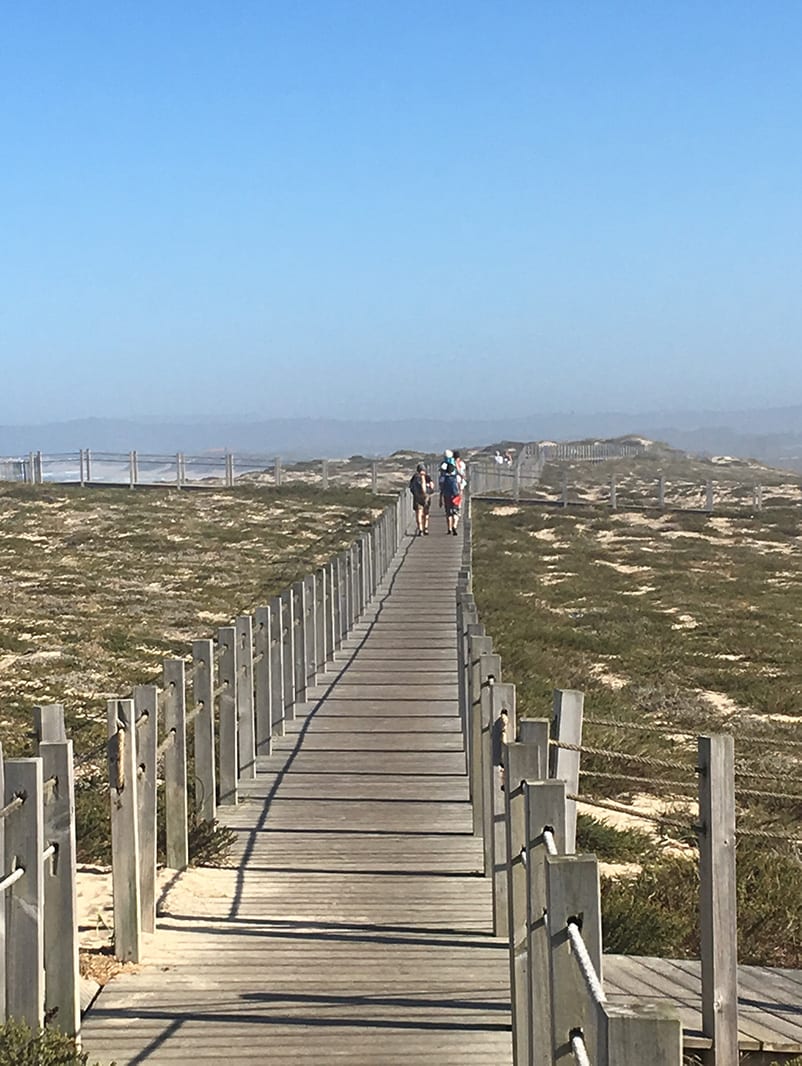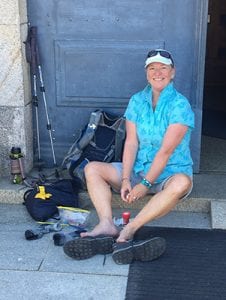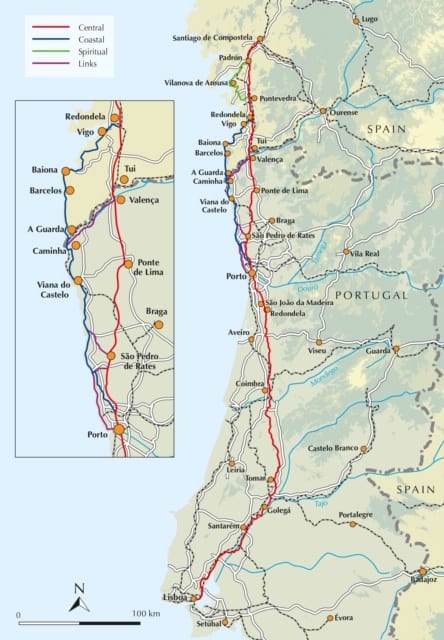Beginning in Baiona, Spain, this eight-day pilgrimage is the perfect taste of the Portuguese Way, also known as the ‘Friendly Way’. The 110-kilometre journey will see you walking the Camino alongside golden beaches and through Galicia’s serene, enchanted forests, eventually joining pilgrims from all over the world as they arrive at Santiago de Compostela’s famous cathedral.
Camino de Santiago: Portuguese Coastal Camino – The final 100kms
8 days / Guided walking
Baiona to Santiago de Compostela
Portuguese Coastal Camino – The final 100kms
TRIP STYLE
DURATION/LENGTH
8 days/110 kms
DATES
Upon Request
START/END POINT
Baiona to Santiago de Compostela
GRADING
Moderate Walk
PRICE P/P TWIN SHARE
From EURO 1,900 / AUD 3,060

The Portuguese Way is the name given to the Camino, or path, that stretches from Lisbon to Santiago de Compostela. There are many starting points – as well as a couple of route variants – one of which is Baiona, a little over 100 kilometres from Santiago de Compostela.
While this leg forms part of the greater Portuguese Way, you’ll be walking from start to finish in Spain’s Galicia province. The route hugs the Atlantic coastline through towns both small and large until Pontevedra, where pilgrims forge inland through vast forests and green hills to Santiago de Compostela. The first half of the journey is characterised by the region’s laidback seaside lifestyle, while the second half offers a quieter, more reflective walking experience through ancient Celtic landscapes.
Day 1 | Baiona
Your Camino de Santiago along the Portuguese Way begins in Baiona, a small town with a big history. It was here, in 1493, that one of Columbus’s ships stopped to resupply and announced that the Italian explorer had ‘discovered’ the Americas on behalf of the Spanish Crown. Though Vigo eventually overtook Baiona as the region’s main port, there are still remnants of the fortresses and battlements that once protected the town. Take some time to explore the Old Town’s narrow streets and sample the delicious local seafood and wine. The Harbour Museum is also worth visiting, where one can see a replica of La Pinta, the ship that brought the good news from abroad.
Day 2 | Baiona – Vigo | 23 km / 5 hours
Tucked away in Galicia’s southwest, Vigo is one of the region’s larger cities with approximately 300,000 residents. It’s a port city and important, economically speaking, for Galicia, though its beaches are a popular drawcard for residents and tourists.
The walk to Vigo takes in expansive views of both the Bay of Vigo and the green hills behind the city that are typical of Galicia. Once again, there are plenty of opportunities to soak up the sunshine, fabulous views of the bay and Vigo has plenty of bars and restaurants to welcome you upon arrival.
Day 3 | Vigo – Redondela | 17 km / 4 hours
The day begins with a climb out of Vigo through the city backstreets. You’ll then join unsealed forest paths for the bulk of the day, walking past eucalyptus trees and along ridges with great views of the coast. Tread lightly: it’s said that Galicia’s enchanted forests are inhabited by ancient witches. You’ll eventually descend back towards the sea and the town of Redondela, your destination for the evening.
Day 4 | Redondela – Pontevedra | 19 km / 4 hours
Today’s walk travels along the coastal inlet of the Rio de Pontevedra and passes through the town of Arcade, a small fishing village famous for its oysters. The path to Pontevedra is paved with ancient stones, a fitting welcome to a city known for its many Romanesque churches and granite squares. The city, which has been mostly pedestrianised, is an absolute joy to walk around and was recognised as one of the world’s best cities to cycle in. There are a number of sights to visit, with the Gothic Santo Domingo Church, Baroque City Hall and the Church of San Francis Monastery being particularly impressive.
Day 5 | Pontevedra – Caldas de Reis | 22 km | 5 hours
Inland we head, past chestnut groves and eucalyptus forests, continuing through to the hamlet of Ponte Cabras and the Santa Maria de Alba, a beautiful church well worth a visit. Shops and cafes are more sporadic than in previous days, so if you tend to need a bit more fuel during the day then it’s worth stocking up before leaving Pontevedra.
A surprise awaits as you emerge from the dense woods of Lombo da Maceira – a statue of Saint James, pointing his cane to direct pilgrims onwards. Trust him, and make your way through the village of Tibo, with its fountain, public washing area and impressive stone cross, before arriving in Caldas de Reis. This town is known for its healing thermal springs, and yes, nobody deserves a spa more than you.
Day 6 | Caldas de Reis – Padron | 19 km / 4–5 hours
You’ll leave Caldas de Reis over the River Umia and enter the woods once more, gradually climbing up to the hamlet of Santa Marina before catching up with the river once more in Padron. This city has a special historical significance for the Camino as it was the first land sighted by the ship that carried the body of St James. It’s also the home of pimientos de padron, the tiny green peppers (be careful, one in 10 has a real bite!) , as well as two of Galicia’s most celebrated writers: the poet Rosalia de Castro and Camilo Jose Cela, who was awarded the Nobel Prize for Literature in 1989.
As this is your final evening on the Camino before reaching Santiago de Compostela, it’s the perfect time to reflect on the journey so far and enjoy the company of your fellow pilgrims. Tomorrow will be a whirlwind of emotions, but tonight is about the people you’ve met, the places you’ve seen and the steps you’ve taken to get to this point.
Day 7 | Padron – Santiago de Compostela | 22 km / 5 hours
The path today will take you through many small villages and hamlets en route to Santiago de Compostela. Your first glimpse of the cathedral’s spires will be from Agro dos Monteiros – a memorable, and often emotional, moment. Continue through the ruins of A Rocha Vella, an old castle, before entering the famous city of Santiago. Follow the path to Santiago Cathedral and take some time to contemplate your achievement. Pilgrims will be coming in from all over the country and it’s just as satisfying watching them arrive.
Collect your Compostela – the official certificate of the Camino de Santiago – and explore the city’s streets. The atmosphere in Santiago is palpable and the food and wine is absolutely mouth-watering. It’s the perfect place to end your journey though the Camino, as they say, never truly ends.
Day 8 | Santiago de Compostela
Your Camino de Santiago comes to an end after breakfast this morning. If you do have some extra time, we do recommend taking a bus – or walking, if you’re game – out to Finisterre to see what was once considered the end of the known world.
Visit www.wanderingtheworld.com.au for more information.
Inclusions
- 7 nights accommodation, all carefully selected to enhance your Camino experience
- Private en-suite facilities
- Daily luggage transfers from hotel to hotel (1 x 20kg bag unless indicated otherwise)
- Daily breakfast
- Three-course dinners with local wine (excluding last night)
- Information packs with route maps and instructions on how to locate hotels
- Luggage identification tags
- Pilgrim’s passport
- Emergency contact details and 24/7 local on-the-ground support
- Pre-departure and ongoing support from Australian office
Optional Inclusions
- Suggested rest days as outlined in itinerary or if required
- Private vehicle transfers to the trip’s starting point
- Single supplement for your own room
- Additional night’s accommodation before or after trip (please advise at time of booking)
Not Included
- Flights
- Travel to trip’s starting point
- Transfers not already outlined in detailed trip itinerary
- Lunches
Accommodation
We know from personal experience that a good night’s rest can make or break a trip, which is why we carefully hand-select all our accommodation. We ensure that our knowledge and firsthand experience of the best places to stay is passed on to all our walkers.
Your accommodation along the Camino is booked in advance, on a twin-share basis with private facilities, and chosen to make your pilgrimage experience as rewarding as possible. You may be staying in a refurbished farmhouse, some of which have been in the same family for centuries, or perhaps a boutique hotel with a chef who would not be out of place in a Michelin-starred restaurant. There are unique properties scattered throughout the different routes including converted monasteries, lighthouses and tiny B&Bs with the most generous hosts you could possibly imagine. Best of all, you’ll always have private en-suite facilities. Wherever you end up, you’ll be well looked after, warm and comfortable and, most importantly, ready to tackle the next day’s walk.
Single supplements are also available so you can enjoy your room with private en-suite. This supplement will apply if you are travelling alone or if there is no gender-share option. You can request a shared room through Wandering the World at the time of booking, however this is not guaranteed.
There are opportunities to upgrade to more luxurious lodgings in many places along the Camino. These are perfect for celebrating special occasions and milestones, or even to enhance your entire journey. We can recommend some very special, unique places to indulge in the Camino hospitality in spectacular style, so please ask us about these options when booking.
Food & Dining
The local cuisine is a definite highlight of your walk. The Camino regions are famous for their culinary delights, and you’ll end up exploring the destination using not only your feet, but also your taste buds.
Breakfast at your place of accommodation is usually continental style and may include cereals, yoghurt, bread, pastries, ham, tea, coffee and juices.
Lunch – at your own expense – will depend on where you are on your walk and what is available. It’s often purchased at a local café or bar, with choices along the trail perhaps including Spanish omelette (tortilla Espanola), tuna empanadas, soups or sandwiches (boccadillo). Alternatively, you may wish to enjoy a picnic in a perfect spot along the path.
Evening meals are a hearty, three-course affair known as the ‘pilgrims’ menu’. These usually consist of a salad or soup to start, followed by a choice of a meat or pasta dish, then finishing with a dessert. This is always accompanied by a bottle of local wine, of course. On occasion, the owner of the accommodation may be in the kitchen preparing the house special, which will not disappoint.
Most evening meals are included on guided group trips, and for self-guided itineraries, Wandering the World can include as many evening meals as you wish. We may strongly recommend this in some places because it’s either been a long walking day or there are limited choices available in certain destinations. We can share our advice and talk to you about this at the time of booking. We can accommodate most dietary requirements, so please let us know in advance.
THE WALKING
Although this trip is guided and you are part of a group, you are free to walk each day at your own pace and in your own time.
You will be provided with an information pack including easy-to-read maps and instructions, complete with directions to guide you on the well-marked paths and tracks. On the Camino, you will be following the yellow arrows and Camino scallop shells, while the Chemin is marked with red and white stripes. This information pack will be available at your joining hotel on the first day of your trip.
TRIP GRADE
Moderate – This itinerary is carefully designed for easy-to-manage walking days that generally average less than 20 km, or approximately 4–6 walking hours. The surfaces are fairly even with moderate ascents and descents. A reasonable level of fitness is recommended.
Given you only need carry a lightweight day pack, this trip is very manageable for those who are new to walking holidays. Whatever your previous experience, preparation and training make all our walks more enjoyable.
LUGGAGE TRANSFERS
Wandering the World arranges a daily luggage transfer to maximise your comfort and enjoyment, so all you need to carry is a day pack. Luggage allowance is one bag per person of no more than 20 kg (13 kg on the Chemin). Your luggage must be left in the reception of your hotel before breakfast (8 am) each day.
Please note:
- It is essential to attach the bag tag provided to ensure your luggage is delivered to your next accommodation.
- Only one bag will be moved each day and additional charges will apply if your bag is heavier than 20 kg (13 kg on the Chemin).
- Should you require special arrangements for additional luggage transfers, these can be made ahead of time and must be paid as part of your final payment to Wandering the World.
GROUP SIZE
Wandering the World’s guided groups have a maximum group size of 12 participants. This small group size means that we have the flexibility to stay in a wider range of accommodations, can dine together in the evenings, have the freedom to walk alone or together, and there are more opportunities to get to know your travelling companions.
TRANSFERS/TAXIS
If, for any reason, you wish to shorten your walking day, there are options along the Camino and in the villages to arrange a taxi.
On some itineraries, there are times when Wandering the World may arrange a transfer for you or can do so at your request. This might happen where small villages do not have accommodation with private facilities, for example, or when we want to take you to a special country property that we know you are going to love. In this case, Wandering the World will either arrange a transfer for you or suggest a taxi.
Transfers on the Camino are common in parts. A simple procedure is outlined in your trip notes explaining the details of your private transfer, the designated meeting point and the agreed transfer time.
WEATHER
The weather and climate on the Camino can vary from country to country, region to region and, of course, from day to day. Each season has its own benefits, with long, warm and sunny days in spring and early summer, while early spring and late autumn tend to enjoy cooler walking temperatures. Some sections may be too hot for walking mid-summer, while others are more likely to be wet at certain times. The experts at Wandering the World can discuss your preferences and guide you when you are planning your trip.
Once you’ve started your walk, the weather can play an important role in your overall enjoyment of the journey. Checking the forecast can be a great help when planning your days. If you do strike hotter weather, leaving early to avoid the warmest part of the day will make a huge difference.
24/7 SUPPORT & CARE
Your information pack will include details of local emergency contacts and international contacts. We have local, on-the-ground support to provide any assistance you may require and we’ll also check-in with your hotel at the end of each day to ensure that you’ve arrived safely.
GETTING THERE / GETTING HOME
This itinerary begins in Baiona and ends in Santiago de Compostela.
The closest airports to Baiona are Porto or Vigo.
From your airport of choice there are bus, train and flight options as per the links below.
Train bookings are recommended. Please note you can only book two months in advance of the date of travel.
Bus: ALSA
Train:
Bus/Train : Rome2Rio
Flights:
Also, check out: Skyscanner OR Spanish Airport Guide
INSURANCE
Insurance is compulsory for everyone who travels with Wandering the World. The insurance policy must include cover against personal accident, medical expenses, emergency repatriation and personal liability. Wandering the World recommends insurance coverage for cancellation to be taken at the same time your deposit is paid, as no exception to the cancellation provisions can be made.
BOOKING AND TRAVEL TERMS AND CONDITIONS
Wandering the World’s full booking terms and conditions are available upon request and will also accompany your initial invoice for deposit.
 “Baiona is a medieval town and a really cute place to the start the 100-odd kilometres to Santiago. We always receive a warm welcome in Pontevedra from Puri, the patron saint of delicious scallops, but before that you have to say hello to Nic, who runs a little bar a few kilometres before Caldas de Reis. His hospitality is infectious, and he’ll even have a bucket of cold water ready for anyone struggling with blisters. The walking is lovely, with green forests and a few grapevines along the path, as well as a number of fruit growers who are always generous and willing to offer an apple and a smile!” – Glenyce, Founder of Wandering the World.
“Baiona is a medieval town and a really cute place to the start the 100-odd kilometres to Santiago. We always receive a warm welcome in Pontevedra from Puri, the patron saint of delicious scallops, but before that you have to say hello to Nic, who runs a little bar a few kilometres before Caldas de Reis. His hospitality is infectious, and he’ll even have a bucket of cold water ready for anyone struggling with blisters. The walking is lovely, with green forests and a few grapevines along the path, as well as a number of fruit growers who are always generous and willing to offer an apple and a smile!” – Glenyce, Founder of Wandering the World.

